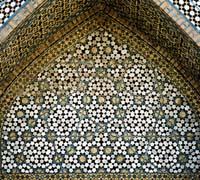Islamic tiling, art and mathematics

In Islamic decoration tiled with complicated geometric figure, called girih, have long been used. From a mathematical point of view, some American experts discover that these images are almost perfect quasi-crystals.
Quasicrystals have a symmetry of five, ten and twelve sides that overlap by turning the fifth, tenth or twelve of a circle. The image they form seems regular, but it does not repeat exactly. An example of this is the setting of the 1453 Darb-i-Imam Shrine in Iran.
Before they thought that to make garlands was enough with the help of compass and ruler, and to use different tiles. But it is clear that to achieve this complex geometry more of that was needed, and surely it would have been the support of Arab mathematicians so advanced at that time.
Buletina
Bidali zure helbide elektronikoa eta jaso asteroko buletina zure sarrera-ontzian











